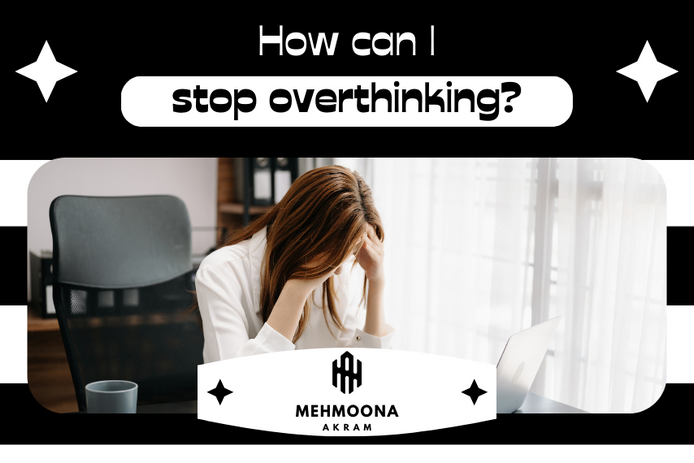
How can I stop overthinking?
Being a human, overthinking runs through my blood; if I am idle sitting, I over think a lot. This is a regular practice that every being engages in, however over thinking may reach dangerous levels and be harmful to our brain’s functioning. According to studies, many people attempt suicide due to boredom and overthinking. As a result, we must employ numerous strategies to demonstrate overthinking. Overthinking is a normal human experience that can present itself in a variety of ways. It is a process in which one dwells on bad ideas and feelings to the point of weariness. Overthinking may lead to tension, worry, and even physical symptoms such as headaches and exhaustion, which can be difficult to manage breaking out from the pattern of overthinking, but these tactics can help. Let us consider a variety of reasons which let us overthink.
Anxiety attacks:
Anxiety may present itself in a variety of ways throughout the body. A quick heartbeat, sweating, shaking, and shortness of breath are all frequent physical signs of anxiety. Anxiety can also result in muscular tension, headaches, and stomach pain. Anxiety can lead to panic episodes, which can induce chest discomfort, dizziness, and a sense of impending doom in extreme situations. It is critical to recognize physical signs of anxiety and get treatment if they interfere with your everyday life. Anxiety treatment options include psychotherapy, medication, or a combination of the two. Working with a skilled mental health practitioner to build an individualized treatment plan that addresses the underlying causes of anxiety is essential.
Meditation:
Mindfulness is the practice of being completely involved with your environment and being present in the moment. It entails paying attention to your ideas, feelings, and experiences without passing judgment on them. By practicing mindfulness, you may increase your self-awareness and become more aware of your own needs and feelings. Mindfulness may also aid in the reduction of stress, anxiety, and depression by helping you to focus on the current moment rather than lingering on the past or worrying about the future. Mindfulness may be practiced in a variety of methods, including meditation, deep breathing, exercises, and yoga. Setting aside time each day to relax might also assist to reduce stress and cultivate mindfulness. Spending a few moments focusing on the current moment and being aware of your thoughts and sensation can assist in keeping your stress levels in check.
Self-awareness:
The capacity to recognize and understand one’s own thoughts, feelings, and behaviors is referred to as self-awareness. It requires the ability to reflect on your experiences and emotions as well as discern patterns in your behavior. You may obtain a better knowledge of your strengths and shortcomings by growing in self-awareness, which can help you make more informed decisions and enhance your relationships with others. Mindfulness, journaling, and counseling can all help to increase self-awareness. It’s also vital to remember that self-awareness is a journey, not a destination. Learning about ourselves and how we feel takes time, and it is critical to be patient and kind to ourselves along the way. Getting in touch with dependable friends and family for help and guidance is also important.
Cognitive restructuring:
The purpose of cognitive restructuring is to modify the way you think about a certain circumstance or experience in order to lessen unpleasant feelings such as worry and despair. Identifying negative ideas and beliefs, reviewing the evidence for and against them, and replacing them with more positive and realistic views are all part of this strategy. Cognitive restructuring can be a helpful strategy for treating a wide range of mental health issues. Anxiety disorders, sadness, and post-traumatic stress disorder (PTSD) are all examples. It is frequently used with other treatment strategies such as mindfulness and exposure therapy. Cognitive Behavioral Therapy (CBT) is a kind of psychotherapy that focuses on modifying negative thinking and behavior patterns in order to improve mental health Reduce stress and enhance mental wellness. It is useful in treating a wide range of mental health conditions; including anxiety, sadness, and post-traumatic stress disorder (PTSD).
Relaxation techniques:
Relaxation techniques are practices that can help reduce stress anxiety and other negative emotions. There AR meant different types of relaxation techniques including:
- Deep breathing exercise: These entail taking slow, deep breaths and paying attention to your breath as you inhale and exhale. This aids to calm your body by slowing down your sympathetic nervous system. You may also concentrate on other portions of your body and intentionally relax them. Regular practice of this can assist to alleviate tension and anxiety.
- Progressive muscle relaxation: Tensing and relaxing different muscle groups in your body helps to relieve stress and promote relaxation. Start with your feet and work your way up to your legs, buttocks, chest, arms, hands, neck, and face. After tensing one muscle group, gradually release it before going on to the next. Take deep breaths and concentrate on releasing the tension while you do this.
- Visualization: Imagine yourself in a serene, relaxing atmosphere and concentrate on the nuances of those surroundings. Techniques for visualizing can assist alleviate stress and mental tiredness while also enhancing attention and concentration. It may also be used to induce pleasant mental states including enjoyment, relaxation, and mental calm.
- Mindfulness meditation: This involves focusing on the present moments and being fully present with your thoughts and emotions without judgment.
- Yoga: This involves a series of physical postures and breathing exercises that can help reduce stress and promote relaxation.
Relaxation techniques can be practiced on your mind or with the guidance of a trained professional. They can be particularly helpful for managing stress and anxiety, but can also be useful for improving sleep, reducing pain, and promoting overall well-being.
Positive affirmation:
Positive affirmation is statements that you repeat to yourself in order to promote positive thinking and self-empowerment. They can help you overcome negative self talk and cultivate a more positive mindset.
Some examples of positive affirmation include:-
- I am capable and strong
- I am worthy of love and respect
- I am confident in my abilities
Repeating positive affirmations regularly can help you build self esteem and improve your overall well being.
Challenging negative thoughts:
Challenging negative thinking is calling negative thoughts and beliefs into question and replacing them with more positive and realistic ones. Examining the evidence for and against negative beliefs, contemplating alternate interpretations for occurrences, and reframing negative thinking in a more positive way can all help. You may lessen symptoms of anxiety and despair and enhance your general well-being by addressing negative beliefs.
Journaling:
Journaling is the practice of regularly writing down your thoughts and feelings. It may assist you in gaining insight into your emotions and behaviors, as well as reducing stress and improving your general well-being. Journaling can also help you understand yourself better and cultivate a happy mentality. It aids in the clarification of your ideas and feelings and can bring clarity and focus. It may also be used to track your progress and successes, which will help you keep encouraged and on track.
Exercise and physical activities:
Exercise is any physical activity performed to improve one’s health, fitness, and well-being. Running, weightlifting, and yoga are examples of such activities. Physical activity is defined as any movement of the body that demands the expenditure of energy. Walking, gardening, and dancing are examples of physical activities. Both exercise and physical activity are vital for maintaining good health and lowering the risk of chronic illness. Exercise is good for a variety of reasons, including increased physical strength, mental health, and general well-being. Physical activity on a regular basis can assist to lower the risk of heart disease, stroke, diabetes, and other chronic illnesses. It also aids in the improvement of mood, energy levels, and sleep quality.
Prioritizing self care:
Making time for activities that support your physical, emotional, and mental well-being is part of prioritizing self-care. It can involve things like exercising, meditating, and spending time with loved ones. How can taking care of yourself help you reduce stress, enhance your mood, and improve your overall quality of life? When it comes to self-care, it’s vital to be deliberate about your choices and make time for things that you love and make you feel good.
Seeking support:
Seeking support entails reaching out to people for assistance when you require it. It can help you manage stress, anxiety, and depression, as well as enhance your general well-being. Friends, relatives, or mental health experts can provide support in a variety of ways, such as chatting, listening, or getting counsel or assistance.
Meditation and deep breathing:
Meditation is a practice in which the mind is trained to focus and create a state of calm and relaxation. Deep breathing is a stress-reduction method that involves taking slow, deep breaths to achieve relaxation. Meditation and deep breathing can both assist with anxiety, depression, and other mental health issues.
Gratitude practice:
Gratitude practise entails consciously concentrating on the aspects of your life for which you are grateful, such as your health, relationships, and accomplishments. It can involve things like maintaining a gratitude notebook, expressing thanks to others, and taking the time to appreciate the little things in life. Practicing thankfulness can help you enhance your mood, reduce stress, and feel better overall. Daily gratitude practice may have a huge influence on our general happiness and mental health. It can also assist us in developing a more optimistic mindset and cultivating more meaningful connections. We may learn to be more attentive and present in our daily lives by engaging in thankfulness practice on a regular basis, allowing us to enjoy the moments that come our way it frequently goes overlooked. This can help us be more appreciative of what we have and more resilient in the face of misfortune.



